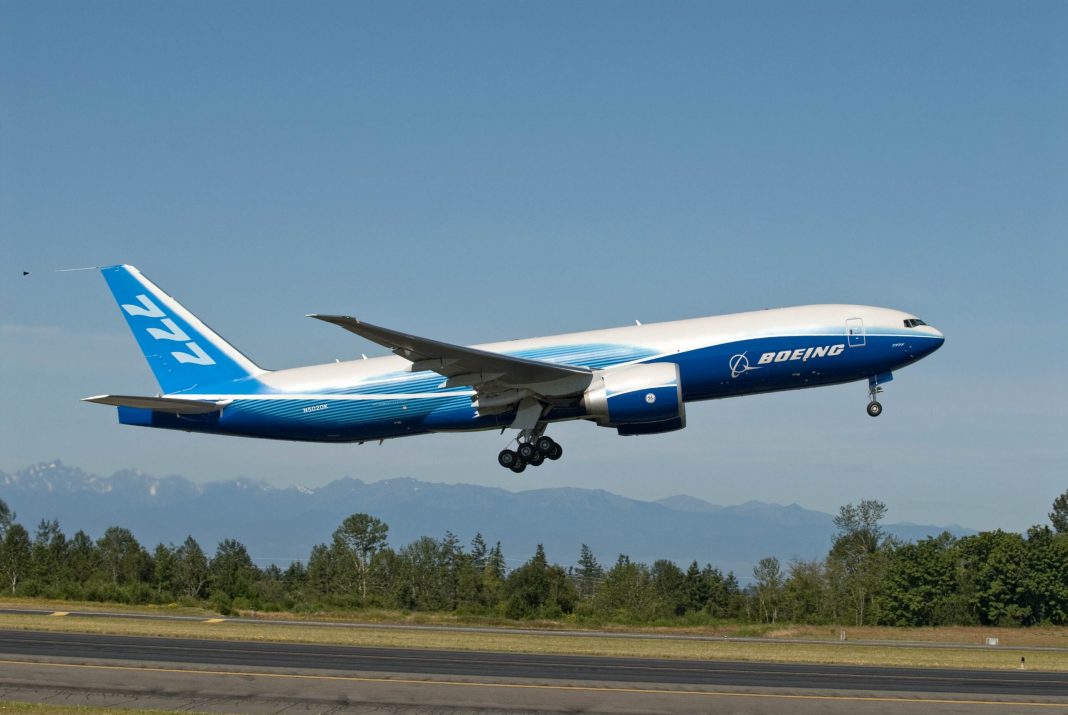The Boeing 777 is the most popular widebody aircraft in the world, with over 2,000 orders for the plane. The 777 was also one of the first high-capacity aircraft to switch to a twin-engine design, while competitor Airbus doubled down on the four-engine A340. So why doesn’t the 777 have four engines?

Development
Boeing first proposed the 777 in the late 1980s as an aircraft bridging the gap between the jumbojet 747s and the smaller 767. Both the aircraft had seen widespread market success in the previous years due to their efficiency, with the 757 and 767 seeing high sales due to their recent ETOPS certification.
The American manufacturer proposed the 777 as the 767-X, which would feature a longer and wider fuselage but maintain the same design as the 767. However, most airlines weren’t interested in a high capacity version of the 767 and wanted a larger, more efficient aircraft which could be used on long-haul routes.

Boeing opted for a clean-sheet design for the 777 but stuck to a twin-engine configuration. The main reasons for this were the recent 757 and 767 models’ success, lower cost for engine development, and an overall lower program price tag. The first designs of the 777 were shown to airlines in late 1989 to much interest.
By comparison, Airbus was attempting to break into the high-capacity widebody market to compete with Boeing and McDonnell Douglas with the A340. This market was dominated by the four-engine 747 and tri-jet DC10, pushing Airbus toward a quad-engine design. Notably, twin-engine aircraft did not have the required ETOPS rating for long-haul flights until 1985, when Airbus was getting ready to publicly announce the A340 design.
Efficiency
The primary reason why Boeing opted for a twin-engine 777 was due to the unparalleled efficiency it offers. Boeing had already noted the use of the 767 on transatlantic operations after ETOPS certification in 1985, bringing down the last barrier for long-haul twinjet operations.
In terms of fuel consumption, the Boeing 777-200 burns 6080kgs of fuel per hour, while the largest variant, the 777-300ER, burns 7500kgs of fuel per hour. Comparatively, the A340-300 burns 6500kgs of fuel per hour, despite seating far fewer passengers, according to data from one source. Aircraft such as the long-range A340-500 could consume up to 8000kgs of fuel per hour, far behind the comparable 777-200LR (6800kgs/hour).

Thanks to its design and twin-engine design the 777 offered airlines much lower fuel costs, which is an important consideration for long-haul flights. While the A340 had a headstart on the 777 in terms of first delivery, the latter’s sales were far ahead.
Cost and weight
One important consideration for the 777 teams was to keep the development cost of the program relatively low. Opting for a twin-engine design helped Boeing achieve this since the manufacturer already had significant experience designing such aircraft. Engine development was also simplified for the 777, with all three major manufacturers offering engines for the launch.
Boeing also famously made the decision to include eight major airlines in the development process. This helped the manufacturer net high sales and design the aircraft in line with airline priorities. The result was an aircraft that offered 10% better seat per mile efficiency than the new, smaller A330. All but one of these airlines (Qantas) placed sizable 777 orders in the future and returned for newer variants.

The 777 is more expensive than the A340, even when prices are adjusted for inflation. A new 777-300ER can run airlines over $375 million, while the A340-600 would only $313 million (adjusted from the 2011 price of $275mn). Despite the price difference, airlines have purchased the 777 in droves, returning for the -300ER and -200LR variants, as well as the latest 777X.
Future development
In the last few decades, Boeing has been a strong proponent of twin-engine planes being the future of aviation. This belief is reflected in the decisions to build the 777 and 787 families instead of focusing on the A340 and A380 as Airbus did.
Boeing’s decision to build the 777 in the 1990s has paid off well in terms of future development. Since the original launch of the 777-200, -200LR, and -300 variants in the late 1990s, the plane has seen significant development. The most popular 777 to date remains the 777-300ER, which entered service in 2004. The plane has become the primary aircraft for long-haul fleets globally.

Most recently, Boeing unveiled the 777X program, which improves upon the efficiency of the previous generation. The 777-8 and 777-9 both offer improvements in terms of emissions and efficiency. The 777X will produce 30% fewer emissions than previous planes and offer 20% more efficiency through the new GE-9X engines.

Conclusion
The decision to build a twin-engine 777 instead of a four-engine widebody like the A340 has paid off in spades. In terms of sales, Boeing has received orders for 2,200 aircraft, delivering 1,646 of those. The more recent 777X has received 309 orders, lower than its predecessor, but a number could grow. Comparatively, the Airbus A340 only received 377 orders in total, prompting Airbus to design new aircraft such as the A380 and A350.

The Boeing 777 will be in aircraft fleets for decades to come, either as passenger variants or freighters. With so many variants and further development, the 777 is undeniably the most successful twin-engine plane today.
But with the likes of the 787 and A350 coming after the 777’s record, it could find itself struggling soon too. This year’s pandemic has impacted the high-capacity 777X too, with many airlines looking to defer deliveries for years.
What do you think about Boeing’s decision to build a twin-engine 777? Could they have made any other design choices? Let us know your thoughts in the comments below!
[ad_2]
Source link


